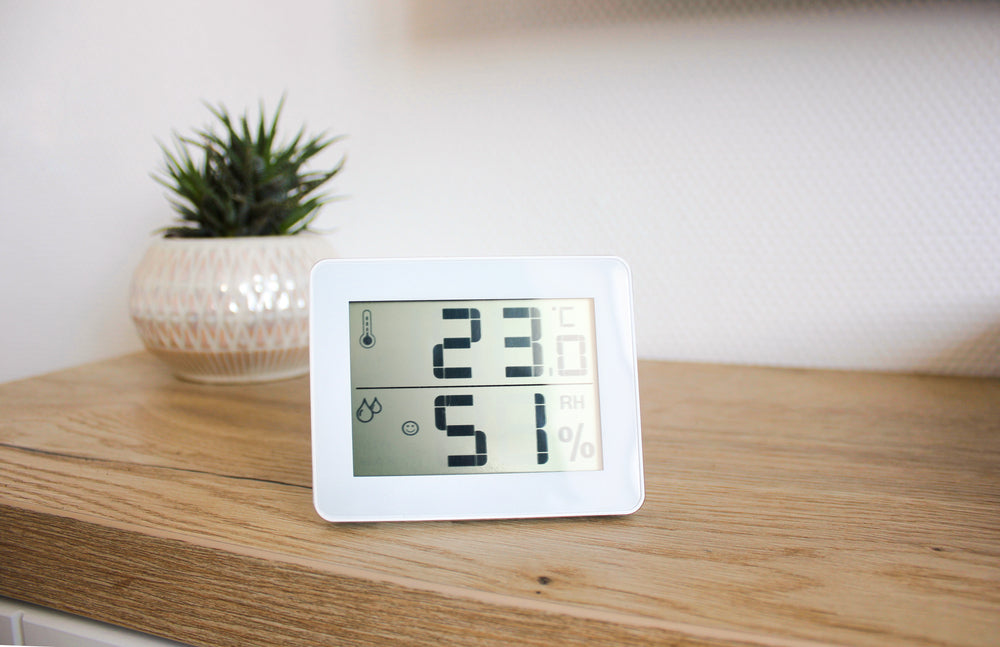Free U.S. Shipping On Orders Over $150

What is The Best Humidity Level for Sleep?
Posted on
The ideal humidity for sleep for most people is somewhere between 30% and 60%. The exact level that will feel most comfortable for you will depend on your particular preferences, where you live and the temperature of your bedroom.
What you certainly don't want is a bedroom that’s too humid or too dry. Both situations can cause a lot of issues and discomfort that affects sleep quality as we’ve discussed in a previous blog post.
Why Does Humidity Matter for Sleep?
When talking about environmental factors that affect sleep, most times we focus on temperature, noise and light. Humidity mattress a lot, too. That’s because it affects your respiratory system.
In fact, respiratory discomfort is one of the first signs that your bedroom is too dry or too humid. You may experience a dry nose, sneezing, stuffiness, irritation and more.
If you have existing respiratory problems like asthma or COPD, too low or too high humidity can trigger serious symptoms and attacks.
Humidity, especially low humidity, also affects your skin. Dry air can make you itchy, cause skin irritation, and trigger acne breakouts. Too much humidity can also lead to irritation and breakouts on your skin because of excessive sweating.
Basically, having too much or too little humidity in your bedroom will make you uncomfortable or even sick, which in turn makes it harder to get good sleep.
During seasons when humidity peaks or drops, many people struggle with insomnia and other sleep disorders. And as we have talked about countless times on the Herctalk blog, sleep deprivation has serious and far-reaching consequences on your health, moods, productivity and life quality.
So keeping your bedroom at the right humidity level is really important.
The Ideal Humidity for Good Sleep
30% to 60% — we have already mentioned that. But why such a wide range?
For one, there’s personal preference. The same way some people love a colder or warmer than average bedroom, it’s the same way that different people have varying humidity preferences. Some people are more comfortable in a slightly more humid environment. Their skin glows and they breathe easier.
On the other end, other people thrive in a slightly drier environment. For them, a humidity level of 30% to 40% is better for sleep. For other people it will be smack in the middle — around 50%.
So it’s up to you to find out what humidity level helps you sleep best. Get a wall mounted weather station that displays indoor humidity and temperature and note the humidity level (as well as temperature) on the nights that you feel most comfortable.
Then try to maintain your bedroom at that level of humidity.
Other factors that determine the ideal humidity for your home include:
- Your respiratory health - your symptoms probably flare above or below a specific range of humidity.
- How easily you sweat. If you get lots of night sweats, you might benefit from lower humidity closer to 30% or 40%.
- Your skin type. Some skins love higher humidity while others are healthiest in a lower humidity environment.
- Your sleep temperature. If you tend to get too hot in bed (because of your bedding or your body type), high humidity can make you feel even hotter. In that case, bringing humidity down closer to 30% will help you feel more comfortable.
How to Deal With a Too-humid Bedroom
Fortunately, humidity is a fairly easy environmental factor to control. You don't have to let it ruin your sleep.
Let’s start with too-humid bedrooms. High humidity typically occurs seasonally, with moisture levels peaking during summer. But your bedroom can also be too humid year round because of the climate of where you live. For instance, some coastal areas tend to stay humid most of the year.
The best way to bring moisture levels down is by using a dehumidifier. It condenses excess moisture out of the air to make the room less humid.
If the humidity level is not excessively high, just cooling your bedroom using the AC or a portable AC might be enough to bring down humidity to a comfortable level.
How to Deal With Dry Indoor Air
Dry air is more common in winter as temperatures drop and air loses its capacity to hold moisture. But if you live in certain places like Arizona, you probably experience low humidity for most of the year.
The best way to deal with dry air is getting a humidifier. It adds water vapor to the air to make it more humid. You can also use an ultrasonic air diffuser.
If you are experiencing low humidity during hot weather, try a swamp cooler, also called an evaporative cooler. It cools the room while adding moisture to the air.
By the way, unlike with high humidity where cooling the room helps reduce it, the opposite doesn't work with low humidity. Heating the room won’t increase humidity. If anything, it makes the air drier. In fact, it’s one of the main reasons why winters can feel so dry indoors as everyone cranks up their thermostat.
Heating the room increases air’s capacity to hold moisture. Unless there are sources of moisture to raise relative humidity like cooking, laundry or a humidifier, the air will feel uncomfortably dry.
So be careful how high you turn up the thermostat. The best thermostat setting for winter is 68F. It keeps you warm enough (layer clothes to get warmer), it saves energy and it keeps the air from getting too dry.
Quick links
Contact
6063 Hudson Road #160
Woodbury, MN 55125
Yo@hercLeon.com
Leave a comment: